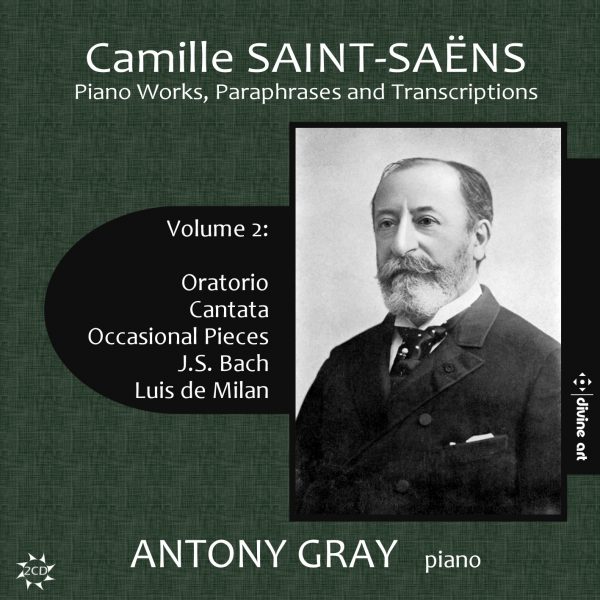American Record Guide
This is an auspicious and impressive beginning to a series devoted to Saint-Saens’s piano music. His solo pieces span most of his long and prolific life (1835-1921), but do not make up a large part of his oeuvre. His compositional output is huge, but outside of Danse Macabre (in Liszt’s arrangement), Carnival of the Animals, and a couple of the piano concertos, most piano music by Saint-Saens people hear regularly is in his chamber music. Antony Gray does not begin his series with the Etudes, Waltzes, and other straightforward piano pieces. He starts with transcriptions, rarities, and occasional pieces. They were all recorded in 2013 or 2015, except Africa, which was done in 2021. Gray is an Australian based in London and has quite a number of recordings. He also has extensive teaching credits, including a marvelous recent 2CD set of duets he made with his students (Divine Art 21234).
Saint-Saens was a composer, conductor, teacher, pianist, and organist. His more than 160 compositions include a lot of substantial works like operas, symphonies, ballets, and concertos. His piano pieces are more of a salon nature, but as we see here in Gray’s two volumes, there are many pieces that go far beyond ones we might refer to as light-weight. All are well crafted, and many are technically quite demanding.
Volume 1 has a disc devoted to Opera and Ballet Transcriptions and one with pieces that refer to locations. Volume 2 has a first disc devoted to Transcriptions from Cantatas and Oratorios along with occasional pieces. These are original works and also some by Berlioz, Schumann, Beethoven, Liszt, and Gounod. The second disc has 13 transcriptions of works by Bach (taken mostly from the cantatas, sonatas, and partitas). New to me were two transcriptions of Fantasies by Luis de Milan.
Geoffrey Burleson is five releases into a highly regarded set (Vol 6 is underway) on the Grand Piano label. Many of the obscure pieces here on Gray’s discs were given first recordings in Burleson’s set, yet Gray still managed to find some pieces that have not been recorded before. There are pieces in each series so far that are not on the other one, but one might assume that in the end they will have very similar contents. The pricing I found on-line puts these Divine Art 2CD sets at about $25 each. The Grand Piano single discs are generally $16. Burleson’s tempos are a little faster in general, and his recorded sound is just a hair better. It is still very close between the two series. I am fortunate to have both, but if
forced to choose, I’d go with Burleson—not that I am disappointed with Gray.
@divineartrecordingsgroup
A First Inversion Company
Registered Office:
176-178 Pontefract Road, Cudworth, Barnsley S72 8BE
+44 1226 596703
Fort Worth, TX 76110
+1.682.233.4978
We noticed you're visiting from Latvia. We've updated our prices to Euro for your shopping convenience. Use Pound sterling instead. Dismiss











![Listen to the full suite of Marcel Dupré’s Variations Sur un Noël, Op. 20 from Alexander Ffinch’s #Expectations release today! listn.fm/expectations [in bio]](https://scontent-dfw5-1.cdninstagram.com/v/t51.71878-15/588904367_2327488161082898_8709236950834211856_n.jpg?stp=dst-jpg_e35_tt6&_nc_cat=105&ccb=7-5&_nc_sid=18de74&efg=eyJlZmdfdGFnIjoiQ0xJUFMuYmVzdF9pbWFnZV91cmxnZW4uQzMifQ%3D%3D&_nc_ohc=H8WFKm530VcQ7kNvwGIamXN&_nc_oc=AdkCU0bHzQ_0XTKomMoPppVnXnL1o2Frx1p2Wu6t5LBXNQzH6Wl0TsxZ8qP8dary_oI&_nc_zt=23&_nc_ht=scontent-dfw5-1.cdninstagram.com&edm=ANo9K5cEAAAA&_nc_gid=SPTFzkrIOD6SSyDEeWIBtg&oh=00_AflfQX8dJ2PQlRfOf-cE5S6uiLcUQ78cXG8yrNvtzs9pew&oe=695530EA)

![“the ‘Manteca’ Paraphrase – a rare foray into the two-piano medium but here played double-tracked – exudes a panache of which Dizzy Gillespie would surely have approved.… [a] recital well worth investigating.” —Gramophone Magazine with high praise for Ophelia Gordon's debut release, Kapustin: Between the Lines!](https://scontent-dfw5-3.cdninstagram.com/v/t51.82787-15/598796470_18303255136283342_540941604740887837_n.jpg?stp=dst-jpg_e35_tt6&_nc_cat=108&ccb=7-5&_nc_sid=18de74&efg=eyJlZmdfdGFnIjoiRkVFRC5iZXN0X2ltYWdlX3VybGdlbi5DMyJ9&_nc_ohc=IC4zZ7tcpb8Q7kNvwExli9l&_nc_oc=AdkjWertDMestob1858EBfq-ZPSKTc3bZmsrCEnRSML_lEfnhcAUU0oX3XgJxqDYQq0&_nc_zt=23&_nc_ht=scontent-dfw5-3.cdninstagram.com&edm=ANo9K5cEAAAA&_nc_gid=SPTFzkrIOD6SSyDEeWIBtg&oh=00_Afl00CtudigeRGbu5zfgTNYSWA2ZPtxXGEVnkusdBxzBWQ&oe=69550B44)